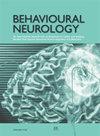锌的预防性给药与游泳运动相结合预防大鼠短暂性缺氧缺血性损伤后的认知情绪障碍和组织损伤
IF 2.3
4区 医学
Q2 CLINICAL NEUROLOGY
引用次数: 0
摘要
运动表现和锌的单独给药对各种神经退行性模型产生保护作用,包括缺血性脑损伤。因此,本工作旨在评估亚急性预防性锌给药和游泳运动在短暂性脑缺血模型中的联合作用。预防性锌给药(2.5 mg/kg体重) 在30 最小颈总动脉闭塞(CCAO)和24 再灌注后h,大鼠在Morris水迷宫(MWM)中进行游泳运动。每天评估学习情况,持续5天,再灌注后第12天评估记忆力;焦虑或抑郁样行为采用高架+迷宫法测量,运动活动采用开放式场地测试。检测颞顶叶皮层和海马的亚硝酸盐、脂质过氧化以及超氧化物歧化酶(SOD)和过氧化氢酶(CAT)活性。通过ELISA测定三种一氧化氮合酶异构体、趋化因子及其受体水平。Nissl染色评估了海马细胞结构,Iba-1免疫组织化学激活了小胶质细胞。单独的游泳运动不能预防缺血性损伤,但与预防性锌给药相结合,可以逆转认知缺陷,降低NOS和趋化因子水平,防止组织损伤,并增加Iba-1(+)细胞数量。这些结果表明,亚急性预防性锌给药结合游泳运动,而不是单独治疗,可以预防短暂缺血模型中再灌注后第12天的缺血损伤。本文章由计算机程序翻译,如有差异,请以英文原文为准。
Prophylactic Zinc Administration Combined with Swimming Exercise Prevents Cognitive-Emotional Disturbances and Tissue Injury following a Transient Hypoxic-Ischemic Insult in the Rat
Exercise performance and zinc administration individually yield a protective effect on various neurodegenerative models, including ischemic brain injury. Therefore, this work was aimed at evaluating the combined effect of subacute prophylactic zinc administration and swimming exercise in a transient cerebral ischemia model. The prophylactic zinc administration (2.5 mg/kg of body weight) was provided every 24 h for four days before a 30 min common carotid artery occlusion (CCAO), and 24 h after reperfusion, the rats were subjected to swimming exercise in the Morris Water Maze (MWM). Learning was evaluated daily for five days, and memory on day 12 postreperfusion; anxiety or depression-like behavior was measured by the elevated plus maze and the motor activity by open-field test. Nitrites, lipid peroxidation, and the activity of superoxide dismutase (SOD) and catalase (CAT) were assessed in the temporoparietal cortex and hippocampus. The three nitric oxide (NO) synthase isoforms, chemokines, and their receptor levels were measured by ELISA. Nissl staining evaluated hippocampus cytoarchitecture and Iba-1 immunohistochemistry activated the microglia. Swimming exercise alone could not prevent ischemic damage but, combined with prophylactic zinc administration, reversed the cognitive deficit, decreased NOS and chemokine levels, prevented tissue damage, and increased Iba-1 (+) cell number. These results suggest that the subacute prophylactic zinc administration combined with swimming exercise, but not the individual treatment, prevents the ischemic damage on day 12 postreperfusion in the transient ischemia model.
求助全文
通过发布文献求助,成功后即可免费获取论文全文。
去求助
来源期刊

Behavioural Neurology
医学-临床神经学
CiteScore
5.40
自引率
3.60%
发文量
52
审稿时长
>12 weeks
期刊介绍:
Behavioural Neurology is a peer-reviewed, Open Access journal which publishes original research articles, review articles and clinical studies based on various diseases and syndromes in behavioural neurology. The aim of the journal is to provide a platform for researchers and clinicians working in various fields of neurology including cognitive neuroscience, neuropsychology and neuropsychiatry.
Topics of interest include:
ADHD
Aphasia
Autism
Alzheimer’s Disease
Behavioural Disorders
Dementia
Epilepsy
Multiple Sclerosis
Parkinson’s Disease
Psychosis
Stroke
Traumatic brain injury.
 求助内容:
求助内容: 应助结果提醒方式:
应助结果提醒方式:


